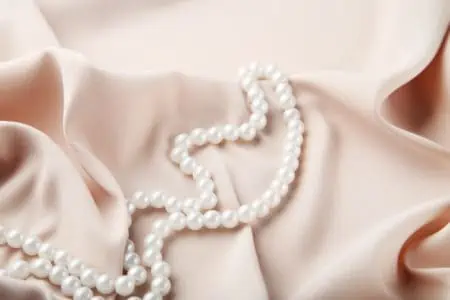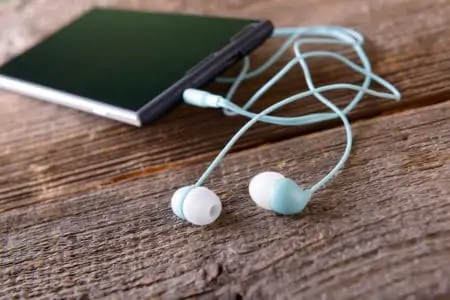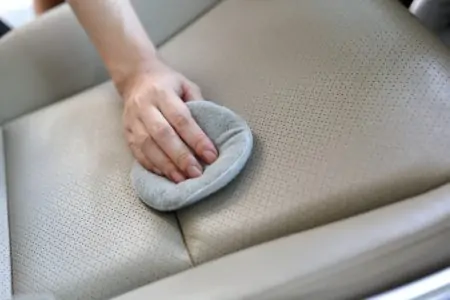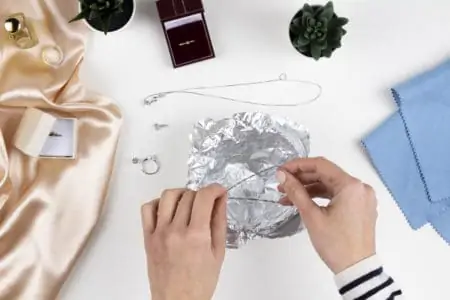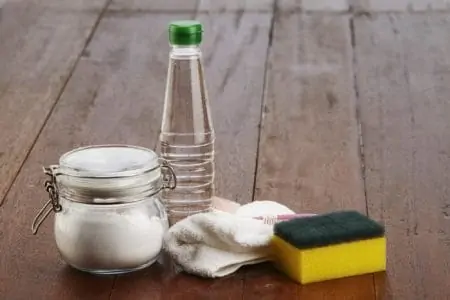When a person acquires a set of pearls, it becomes an utmost priority to keep them clean and polished.
It’s natural to worry about damaging them, especially if you clean them at home yourself. But not to panic — we’ve done the research and analyzed the safest and most effective methods for cleaning pearls yourself.
If you’re wondering how to clean pearls, shine pearls, and even spruce up fake pearls, keep reading.
Key Takeaways
- Clean pearls after each use with a damp jewelry cloth and air dry them flat before storing.
- Prevent pearl yellowing by storing them in ventilated areas and wearing them frequently.
- To make pearls shine, polish them with a jewelry cloth and maintain a humid storage environment.
- Avoid cleaning pearls with vinegar, rubbing alcohol, and abrasive cleaners to prevent damage.
How Often to Clean Freshwater Pearls
If you have lovely and unique freshwater pearls, you’re in luck. These beautiful pearls are unlike any other and are an elegant statement piece. But they do require careful maintenance.
Ideally, you should clean freshwater pearls after every wear. This doesn’t need to take too long. Simply wipe them with a dry jewelry cloth. If they’re particularly dirty or oily, use a dampened jewelry cloth and lay them flat to dry completely before storing or wearing them again.
If you have cultured pearls, we recommend cleaning them after every use, too.
Pro Tip
No matter the type of pearl, as long as they are real, you should aim to clean them using this method after every wear. This will keep them clean, polished, and scratch-free.
Do Real Pearls Turn Yellow?
If your pearls have turned yellow, that’s an indication that it’s a real pearl. This is part of the pearl’s aging process (1).
A pearl’s organic composition changes when there is no air circulation or moisture. This leads to yellowing.
You can prevent this by storing them in ventilated areas, ensuring they’re not in hot, dry locations, and by wearing the pearls frequently.
Here are some more ways to tell a real pearl from a fake one:
- The tooth test: Softly rub the pearl against your tooth. If the surface feels gritty, this is a real pearl. If it feels smooth, this is a fake pearl.
- The touch test: When you touch a real pearl, you’ll notice it feels cold at first but gradually warms up. Fake pearls already feel warm to the touch but gradually become sticky when worn.
- Use a magnifier: Under a magnifying glass, you’ll see real pearls have small imperfections and differences. Fake pearls look unrealistically perfect and identical.
- Rub two pearls together: You may not want to do this, especially if your pearls are a family heirloom. But when you rub genuine pearls together, you’ll notice a powder. When you rub fake pearls together, it’s smooth, and no powder appears.
- Check the shape: Fake pearls tend to be perfectly circular and identical. Natural pearls come in all shapes and won’t be identical to the pearl next to them.
How to Clean Pearls
It’s important to clean real pearls and cultured pearls regularly. We’ll walk you through the entire cleaning process so that you always know what to do after each wear.
- Time: 10 minutes
- Difficulty: Easy
What You’ll Need
- A jewelry cloth, ideally made from cotton or bamboo.
- Cotton muslin cloth
- Pure soap
- Chalk
- Stone
- Toothbrush
- Small basin
- Warm water
Here is the best method for cleaning pearls. You don’t have to do all these steps if your pearls aren’t filthy. But if you do need to deep clean your pearls, follow every step.
1. Wipe the Pearls With Water
Dampen a jewelry cloth in water. Wipe each individual pearl carefully with the cloth.
2. Let the Pearls Air Dry
Leave the pearls to air dry completely. That’s all you need to do for daily cleaning after each use. For a deeper clean, follow the rest of the steps.
3. Clean Pearls With Soapy
Mix pure soap with warm water in a small basin. Dip a cotton muslin cloth into the soapy water. Gently rub each individual pearl. Make sure you reach all sides of the pearls. This will give the pearls a deeper clean, due to the soap.
4. Dry the Pearls With a Cloth
Using a dry area of your muslin cloth, dry the pearls gently.
5. Clean the Clasp With Chalk
If you need to clean your clasp, it’s time to get the chalk out. Rub chalk over a stone to create a loose powder.
Dust your toothbrush over the chalk powder to get a little onto the bristles. Gently rub the toothbrush over the clasp to scrub off dirt and debris.
Avoid getting chalk on the pearls. If you do, follow the cleaning steps again.
6. Wipe Down Clasp
Remove the chalk residue with your jewelry cloth. Lay the pearl necklace down flat to let the pearls and clasp dry completely before storing.
How to Clean Pearls That Have Yellowed
The bad news is: if your pearls have become really yellowed over the years, there may be no turning back. The good news is: we can always try. If you’re wondering how to clean pearl earrings, necklaces and bracelets, give this method a go.
- Time: 20 minutes
- Difficulty: Easy
What You’ll Need
- A jewelry cloth, ideally made from cotton or bamboo.
- Cotton muslin cloth
- Pure soap
- Chalk
- Stone
- Toothbrush
- Small basin
- Warm water
- Acetone nail polish remover
1. Clean the Pearls
Using the above method, clean your pearls with pure soap and warm water.
2. Rinse Pearls With Cold Water
Run the pearls under a gentle stream of cold water from the faucet.
3. Clean Pearls With Acetone
Dampen a cotton muslin cloth with acetone nail polish remover. Gently wipe the pearls with the cloth. This may whiten your yellow pearls.
4. Air Dry and Store Correctly
Lay the pearls flat to dry for a few hours. Don’t store the pearls in an airtight container as they need a bit of moisture and airflow to prevent yellowing.
Tips to Make Pearls Shine Again
If your pearls have lost their natural luster, there is no need to worry. Here are a few things you can try to polish your pearls:
- Polish them with a jewelry cloth after each wear. This removes body oils, moisturizers, hairsprays, perfumes, and more which can dull a pearl’s natural shine.
- Wear them often. The moisture from your body helps keep pearls shiny.
- Store the pearls in a humid environment. This naturally aids their shine.
- Wipe pearls with a cleaning cloth soaked in purified water.
- Dry the pearls with a special pearl-cleaning cloth.
We recommend bringing the pearls to your local jeweler once per year. They will check the integrity of the jewelry and restring them if necessary. They will also ensure an efficient and safe clean of the pearls.
Avoid This
How to Clean Fake Pearls
Not every pearl is found in an oyster! If you have fake pearls, we’re not forgetting about you. They need cleaning too!
- Time: 5-10 minutes
- Difficulty: Easy
What You’ll Need
- Mild dish soap
- Bowl
- Water
- Towel
1. Wash With Soapy Water
Pour one tablespoon of dish soap into a bowl of lukewarm water. Mix well. Submerge the fake pearls into the lukewarm soapy water. Use your fingers to rub any dirt and oil off.
2. Rinse and Dry
Maintaining Pearls Correctly
The key to ensuring your pearls stay beautiful is all in the maintenance. We wish they came with a list of the most important tips, but since you may not know them, we’ll fill you in.
Here are crucial tips for maintaining your pearls:
- Last on, first off: When getting ready, put your pearls on last. When undressing, take them off first. This ensures you apply your perfume, lotions, and other products before putting on your pearls. These products can ruin your pearls.
- Dry well: Before storing, let the pearls and strand dry thoroughly. This prolongs the elasticity of the silk strand.
- Wear your pearls: There is no need to save your pearls for a special occasion. If you wear your pearls frequently, you increase the chances of them looking beautiful and shiny. Your body heat and other natural elements are great for the pearls.
- Avoid harsh chemicals: Don’t subject your pearls to harsh cleaning chemicals or strong perfumes. Take them off before cleaning since household cleaners can damage the pearls.
- Store them safely: Store your pearls flat, never tangled, in a cloth-lined box. Avoid airtight boxes since pearls need to breathe. Wear them regularly. Don’t use jewelry racks or trees.
- Watch what you wear: Don’t wear pearls with abrasive or rough fabrics, as this can scratch and damage the pearls.
- Not during exercise: Take your pearls off before exercise. This includes swimming. Chlorine, prolonged exposure to water, and sweat can damage pearls.
- No cooking while wearing pearls: Remove pearls before cooking. Acids, grease, and heat can stain pearls.
- Restring every two years: Take your pearls to a jeweler every couple of years to get restrung. The thread can wear down without you noticing. The last thing you need is for it to snap one day while you’re out and about. You could damage and lose some pearls.
FAQs
Pristine Pearls
The bottom line is to wear your pearls often, clean them after every use, and visit professional jewelers annually.
Don’t keep your pearls hidden away for months on end. They want to come out and play! Plus, wearing them often keeps them shiny.
Avoid keeping them damp, spraying perfume over your pearls, and wearing them with rough textures.
At the end of the day — enjoy wearing your beautiful pearls!
